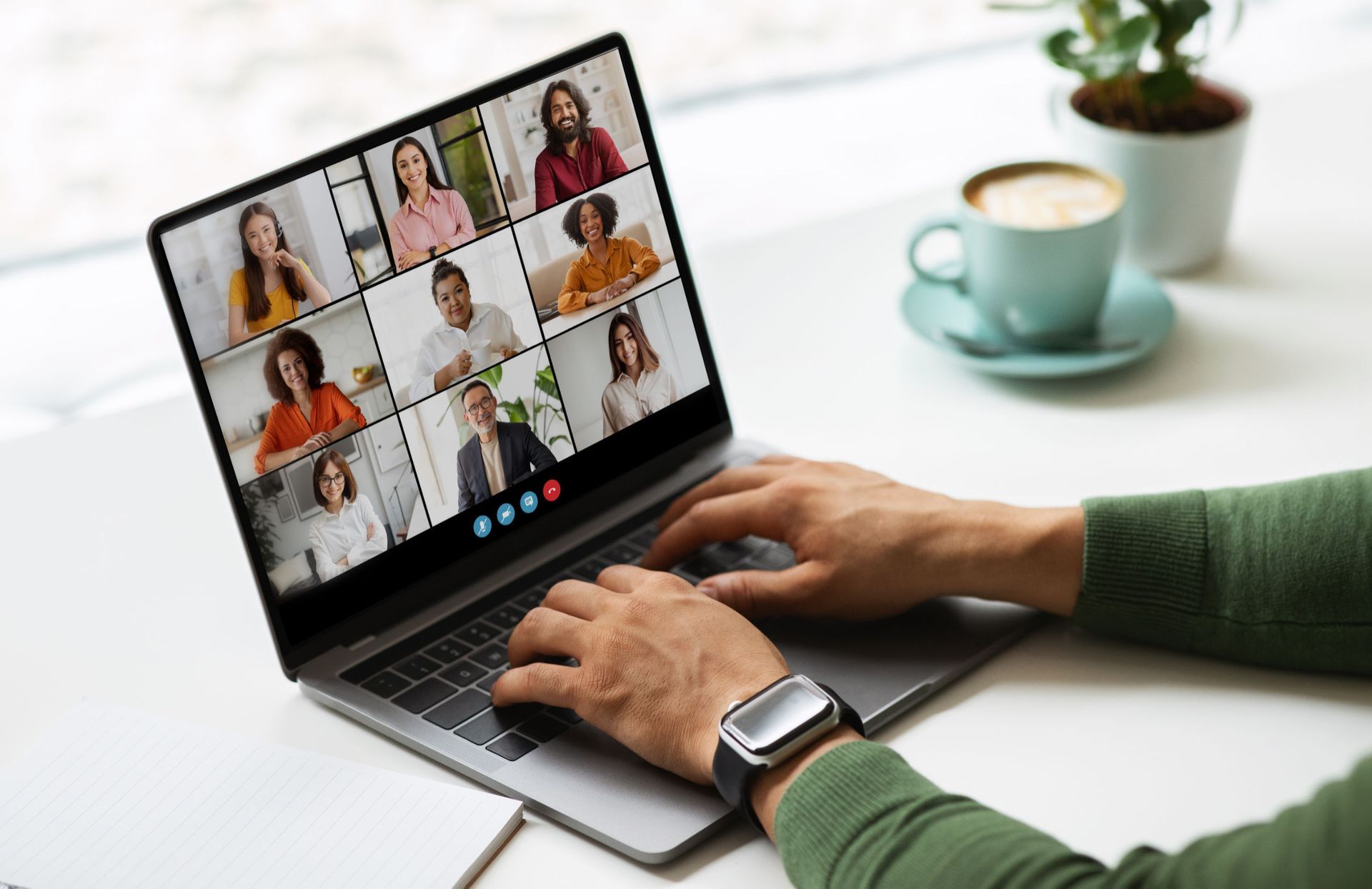How to plan and execute a shopping event: a complete guide
October 9, 2024
Live-streaming shopping events have emerged as a powerful tool for revolutionizing the way businesses connect with customers, boost brand visibility, and stay ahead of the competition. By combining immersive storytelling, real-time engagement, and product showcases, you can expand your local and global following, drive sales, and foster lasting brand loyalty.
With 80% of consumers relying on demonstration videos to inform their purchasing decisions, the power of video storytelling is undeniable. However, planning a virtual event can be daunting, especially for first-timers.
This comprehensive guide will walk you through every step of the process, from defining your objectives and target audience to selecting the perfect products and implementing effective marketing strategies. We'll cover every essential aspect to ensure your event exceeds expectations and delivers exceptional return on investment (ROI).
Customer experience and brand loyalty is all that matters
Virtual shopping events create engaging and memorable interactions, making customers feel part of a cohesive brand story. This approach leads to increased satisfaction, brand loyalty, and a higher likelihood of purchases.
These events foster intimate shopping experiences, creating opportunities for stronger customer-brand relationships. The result is increased trust and positive word-of-mouth recommendations, which are crucial for brand growth and customer retention.
By focusing on delivering exceptional customer experiences, virtual shopping events strengthen brand loyalty. They provide a platform for personalized interactions, real-time engagement, and tailored product showcases, all of which contribute to a deeper emotional connection between the customer and the brand.
Remember, in the competitive landscape of e-commerce, customer experience and brand loyalty are key brand differentiators. Virtual shopping events offer a unique opportunity to excel in both areas, setting your brand apart and fostering long-term customer relationships.
In-person vs. virtual shopping events
When planning a shopping event, one of the first decisions you'll need to make is whether to host it in-person or virtually. This choice will significantly impact various aspects of your event, from budget and logistics to audience reach and engagement strategies.
In-person shopping events have been the traditional way of connecting with customers, offering unique opportunities for face-to-face interactions, hands-on product demonstrations, and immediate feedback. These events allow for a tangible experience where attendees can physically interact with products, meet the organizers and vendors, and enjoy the atmosphere created by the event's setting.
Virtual shopping events, on the other hand, have gained immense popularity, especially with advancements in technology and the increasing need for remote connectivity. These events offer a different set of advantages, such as cost savings, wider accessibility, and global audience reach. With the use of digital platforms, live broadcasts, chat rooms, and virtual showrooms, virtual events provide attendees with the opportunity to participate from anywhere.
The decision between an in-person or virtual shopping event depends on several factors, including your target audience, budget constraints, and organizational objectives.
Virtual shopping events as part of your marketing strategy
Incorporating virtual shopping events into your marketing strategy isn't just advantageous—it's essential for businesses looking to expand their reach, drive sales, and build lasting relationships with customers. Virtual shopping events provide a unique platform to connect with customers, offer personalized shopping experiences, and leverage technology to enhance engagement and sales.
Benefits
- Expanded reach: transcend geographical barriers and tap into new markets
- Cost-effectiveness: lower overhead costs compared to in-person events
- Data-driven insights: gain valuable analytics for refining marketing strategies
- Brand differentiation: stay ahead of competitors with innovative experiences
- Adaptation to digital trends: align with evolving consumer preferences
Key Considerations
- Technology requirements: consider a platform that includes e-commerce integration to offer an immersive experience
- Engagement strategies: include interactive demos, Q&A sessions, and exclusive discounts
- Promotion and marketing: promote your event on social media, email marketing, influencer partnerships
- Customer support: offer technical assistance and product inquiries
- Feedback and improvement: collect feedback for future event refinement
- Integration with existing channels: align virtual events with social media, email, and in-store experiences
- Measuring ROI: track engagement, sales, and customer acquisition costs
How long in advance should I start planning?
When planning a virtual shopping event, timing is crucial. Ideally, the sooner you start, the better. Experienced event planners should begin at least three weeks in advance, allowing time to coordinate with stakeholders, finalize schedules, promote the event, and address technical issues.
For first-time hosts, a five-week lead time is recommended to familiarize yourself with tools, develop content, and troubleshoot challenges.
Remember, a well-planned event can significantly impact your brand's reputation and sales, so invest the necessary time to get it right. If you're short on time, prioritize essential elements and consider simplifying your event structure.
Phase 1— Creating your live-streaming strategy & planning your event
When planning live-streaming events, especially for beginners, it's crucial to start small and grow gradually. This approach allows you to set high standards, gather valuable feedback, and refine your strategies without the overwhelming pressure of large-scale events. As you gain experience, you'll identify successful elements to incorporate into future events, leading to an iterative process of improvement. This method not only reduces the risk of mistakes and technical issues but also helps build confidence and expertise. Over time, your events will become increasingly effective, strengthening your brand, boosting customer engagement, and expanding your reach through positive word-of-mouth.

Define your objectives
Before you go deeper into planning your online event, it's essential to have a clear understanding of your goals. Common objectives for live shopping events include:
- Enhancing the customer's shopping experience
- Building your brand
- Generating engagement
- Gathering feedback
- Generating revenue
- Expanding your customer base
Focus your efforts and align your content with your objectives by setting specific, measurable, attainable, relevant, and time-bound (SMART) goals. This approach ensures that your strategy is clear, focused, and capable of delivering tangible results.
Define who is your target audience
Understanding your audience is crucial for a successful virtual shopping event. Here's how to gain comprehensive insights:
- Identify and understand: research demographics, interests, pain points, and needs of your target audience. Analyze social media behavior and study your existing customer base.
- Competitive analysis: examine competitors' events to identify gaps and differentiate your offering.
- Consider external factors: account for time zones and holidays to optimize event timing.
- Create audience personas: develop detailed fictional representations of ideal customers to guide marketing efforts.
- Tailor marketing messages: craft personalized content addressing specific audience needs and highlighting unique selling points.
- Engagement strategies: utilize various marketing channels and create interactive content to generate excitement.
- Collaborations: partner with influencers or complementary brands to expand reach and credibility.
- Feedback and iteration: collect and use feedback to refine future events and strategies.
By thoroughly understanding your audience, you can tailor your event to meet their expectations, driving engagement and sales. Remember, your audience insights will also inform product selection and discount strategies in later stages of planning.
Select the perfect products
Choosing the right products is also critical for driving engagement, attracting attendees, and increasing sales. Consider the following essential factors:
- Limit selection: feature no more than 10 products to maintain focus.
- New and best-selling products: feature new releases, bestsellers, and products with positive customer feedback.
- Seasonal relevance: align products with seasonal trends, holidays, or special occasions.
- Exclusivity: offer limited-edition or exclusive products to create urgency.
- Visual appeal: choose products with high-quality images, videos, and descriptions.
- Variety: cater to diverse tastes, preferences, and budgets
Additional strategies
- Pair underperforming products with high sellers.
- Target niche audiences with specific products.
- Showcase products that represent your brand identity.
- Leverage customer feedback and reviews.
- Plan interactive demonstrations and tutorials.
Pre- and post-event considerations
- Promote featured products before the event.
- Follow up with attendees after the event, offering special deals or discounts.
Define deals and discounts
Attractive offers are essential for driving sales during your virtual shopping event. Consider these key strategies:
Types of Offers:
- Exclusive discounts: available only for attendees during the event
- Limited-time promotions: create urgency with flash sales or countdown deals
- Bundle deals: combine products at a discounted price
- Free shipping: remove a common purchasing barrier
- Buy one, get one (BOGO) deals: provide tangible value
Balancing profitability and customer satisfaction:
- Experiment with different incentives
- Test various offers to find what resonates with your audience
- Adjust to ensure attractiveness and sustainability for your business
Promoting your offers:
- Display prominently throughout the event using banners and graphics
- Announce offers at the beginning, during, and towards the end of the session
- Promote before the event to generate buzz and drive attendance
- Make real-time announcements during the event
- Follow up with attendees’ post-event, reminding them of deals and extended offers
By strategically defining and promoting your deals and discounts, you can create a compelling reason for customers to make immediate purchases during your virtual shopping event.
Establish an initial budget
Create a preliminary budget for your virtual shopping event to ensure proper financial planning. Consider core expenses such as technology, production costs, product inventory, marketing, and staffing. Account for variable expenses like giveaways, speaker fees, and order processing. Include miscellaneous costs for shipping, content creation, and post-event analytics. Set aside funds for unforeseen expenses and a contingency fund.
Sponsors can provide crucial financial backing, resources, and promotional support for your event. Their contributions can help cover expenses and boost the event's reach through collaborative efforts.
Use your budget as a financial roadmap to guide decision-making and resource allocation. Consider potential revenue from sales and anticipated ROI from marketing efforts and brand exposure. This approach will support a successful and profitable virtual shopping event.
Set attendance goals
To ensure success, establish clear and measurable attendance goals aligned with your overall strategy. Consider key objectives such as registration numbers, attendee demographics, geographical reach, engagement, and discovery opportunities. Use audience personas, SMART goals, and analytics tools to track progress and optimize your strategy.
Establish roles and responsibilities
Establishing clear roles and responsibilities is crucial for efficient event planning and execution. Identify key areas of work, define specific roles based on skills and expertise, and establish clear communication channels. Encourage collaboration, provide necessary resources, and regularly monitor progress. Ensure role overlaps and backup plans are in place, and establish a process for conflict resolution. After the event, evaluate team performance to identify areas for improvement in future events.
Create compelling content that engages
To create engaging content for your virtual shopping event, start by developing a well-timed content strategy that can be refined and reused.
Use audience personas and key questions to tailor your content to attendees' needs and interests. Incorporate multimedia elements, interactive segments, and gamification to enhance engagement. Use demonstrations and storytelling to show how to use the products or provide styling advice.
Structure your session with a clear introduction, product showcase, and a call to action (CTA), aiming for a 30–60-minute duration.
Finally, develop a content calendar to organize information flow before, during, and after the event. This approach will help boost brand awareness, perception, and sales while providing value to your audience.
Give your event an effective name
Your virtual shopping event's name is the first impression attendees will get, setting expectations and sparking curiosity. To make a lasting impact, choose a name that is:
- Catchy and memorable;
- Clearly communicative of the event's value and nature;
- Simple, culturally sensitive, and legally compliant; and
- Enhanced with industry-relevant terms, pop culture references, and SEO-friendly keywords
If you're struggling for ideas, use AI or name generator tools for inspiration. A well-chosen name will help attract attendees and set the stage for a successful event.
Should you hose a multi-session or a one-session event?
The choice between hosting a multi-session event or a single short session depends on various factors.
Multi-session events are ideal for diverse audiences, varied product ranges, deeper engagement opportunities, and accommodating global time zones. It is important to note that they also provide more data collection opportunities.
Single short sessions are perfect for focused initiatives like product launches, promotions, or limited-time offers. They offer a streamlined experience and simplified promotional strategy. They're also a great starting point for new event organizers or those transitioning to online events.
Consider your event objectives, audience preferences, product complexity, available resources, desired engagement metrics, and technical capabilities to determine the most effective format.
Choose the right format for your sessions: Pre-recorded, live-streamed, or hybrid
When selecting a format for your virtual shopping event, consider three main options:
- Pre-recorded sessions: ideal for product demos, tutorials, and high-end content, these sessions offer flexibility, control, and superior production value. By minimizing technical risks and allowing for content reuse, they provide a seamless viewing experience. However, they may sacrifice real-time engagement.
- Live-streamed sessions: ideal for product launches, Q&A sessions, and interactive demos, these sessions deliver authenticity and real-time engagement. They allow you to tap into current trends and provide a cost-effective solution. However, they require meticulous planning to mitigate technical risks and ensure a seamless experience.
- Hybrid sessions: combine pre-recorded and live elements, maximizing engagement and flexibility. They offer the best of both worlds but require careful planning and may involve higher costs.
Consider factors such as engagement analytics, audience reach, and post-event accessibility when making your decision. Choose the format that best aligns with your event goals, audience preferences, and technical capabilities to ensure a successful virtual shopping experience.
Create your event schedule
When creating your event schedule, consider these key factors:
Determine the date:
- Choose a date that maximizes audience availability
- Consider establishing a regular schedule for recurring events
- Accommodate global audiences with multiple sessions if necessary
Select the time:
- Identify optimal time slots for your target audience
- Adjust for different time zones
- Avoid conflicts with competitor events
Set the duration:
- Aim for 30–60 minutes to maintain engagement
- Break the event into timed segments
- Include buffer time for unexpected issues
Create a perfect event flow by identifying essential segments, maintaining a cohesive narrative, incorporating breaks, planning audience interaction points, and preparing backup plans. Simulate the event beforehand and be prepared to gather feedback during and after the event. This approach will help ensure a smooth, engaging virtual shopping experience for your audience.
What to consider when selecting speakers or influencers
Choose speakers or influencers who embody your brand, attract customers, and engage your audience. Authenticity and genuine connections are crucial for driving meaningful interactions.
Influencer selection criteria
Unless you have a substantial marketing budget, or you are a major brand, consider micro-influencers (10K-100K followers) for their trust, credibility, and targeted audiences. Ensure they have:
- High engagement rates (min. 10%)
- Content expertise relevant to your event
- Previous live event experience
- Authenticity verified through tools and metrics.
Research and identify potential influencers through social listening, databases, and networks.
Effective collaboration
Involve selected influencers in event planning and promote through their platforms. Offer personalized compensation options and draft clear contracts outlining expectations and compensation. Plan post-event engagement activities and cross-promote on your channels to maximize reach and impact.
Why do you need your customers to register for your event
Requiring customer registration for Virtual Shopping Events (VSEs) is crucial for engagement, participation, and event success. Registration provides valuable benefits, including audience data collection, enhanced event planning, and commitment from attendees.
Key benefits of registration
By collecting registration data, organizers can:
- Tailor experiences and offerings to attendees' demographics, preferences, and interests
- Plan resources efficiently, ensuring a smoother and more personalized experience
- Foster commitment and engagement, leading to higher attendance rates
- Offer personalized communication, follow-up opportunities, and targeted promotions
- Gain marketing insights, map customer journeys, and ensure legal compliance
Practical advantages include higher attendance rates, efficient resource management, tailored communication, improved interaction, and the ability to offer registration incentives.
Additionally, registration data provides valuable analytics for post-event reporting and future event optimization. By requiring registration, organizers can create a more engaging, personalized, and successful virtual shopping experience.
Branding
Effective branding is crucial for making your virtual shopping event stand out and ensuring ROI. It conveys distinctiveness, maintains consistency, and demonstrates professionalism.
Key elements include customizing your event platform, incorporating visual elements like logos and colors, using consistent typography and messaging, and integrating interactive branded elements. Extend your branding through pre- and post-event content, swag, and storytelling. Leverage user-generated content, brand ambassadors, and social media integration to enhance brand perception and reach.
A well-executed branding strategy creates a cohesive, memorable experience that reinforces your brand identity and builds trust with attendees.
Get sponsors on board
Securing sponsors for your virtual shopping event is crucial for its success and financial viability. Sponsorships can open up opportunities for building brand awareness, increasing brand exposure for both you and your sponsors, and attracting more customers to your event. Additionally, sponsors can provide valuable resources, expertise, and credibility, enhancing the overall quality and appeal of your virtual shopping experience.
To effectively attract and secure sponsors:
- Highlight unique benefits, such as increased brand exposure and access to a targeted audience.
- Craft compelling sponsorship packages featuring success stories, event reach details, and joint marketing proposals.
- Offer various sponsorship levels and customization options to suit different needs and budgets.
- Maintain clear communication throughout the negotiation process, emphasizing mutual benefits.
- Provide detailed post-event reports and consider exclusive sponsor offers to add value.
- Plan for seamless integration of sponsor content into your event.
- Gather feedback after the event to improve future partnerships.
- Discuss potential long-term collaborations for ongoing support.
- Ensure all agreements are documented in clear, legally binding contracts to protect both parties.
By effectively leveraging sponsorships, you can create a more robust, attractive, and financially sustainable virtual shopping event.
Develop a marketing plan for your virtual shopping event
Develop a comprehensive marketing strategy by defining:
- Event objectives
- Target audience (demographics, interests, pain points)
- Unique selling proposition (USP)
- Products/discounts
- Market location
- Lead time
- Expected results
- Budget allocation (across channels)
Implement your plan through:
- Engaging content (landing pages, social posts, emails, teasers, testimonials)
- Automated emails
- Social media marketing
- Paid advertising
- Influencer and sponsor partnerships
- Branded hashtags
- Analytics and tracking (website traffic, engagement, conversion rates)
Key Considerations:
- Personalization (segmented content and offers)
- Exclusive offers (limited-time discounts, early access)
- Post-event follow-up (surveys, communications)
Adjust your focus from awareness to excitement as the event approaches, driving engagement and urgency.
Delivering exceptional customer support
Provide top-notch customer support through engaged chat moderators, help desk agents, and store attendants. Train them to offer personalized advice, to suggest additional items, build a lasting relationship with customers and address hesitations.
Foster a sense of community through interactive discussions and timely responses. Ensure support availability before, during, and after the event through multichannel support (live chat, email, phone, social media). Implement feedback mechanisms, escalation procedures, proactive support, and analytics to continually improve support services and drive customer loyalty.
Make contingency plans
Develop contingency plans to mitigate potential risks that could disrupt your virtual event, such as technical difficulties, security breaches, last-minute cancellations, or unforeseen events.
Identify high-risk scenarios, evaluate their likelihood and impact, and assess third-party services' reliability. Consider factors like attendee frustration, scheduling conflicts, and decreased engagement if postponing the event. Establish a plan to address potential issues, minimizing damage to your brand, revenue, and team morale.
Phase 2 — Preparing for the event

As your virtual shopping event approaches, focus on finalizing key elements to ensure a smooth execution.
Coordinate closely with speakers and influencers, reviewing their content and addressing any technical requirements. Encourage them to promote the event through their channels to boost visibility.
Confirm expectations with sponsors and provide them with anticipated benefit metrics. Use event management software to analyze registration data, refining your content and strategy based on attendee insights.
Practice makes perfect
Thorough rehearsal is crucial for a successful virtual shopping event. Conduct comprehensive dry runs involving all relevant teams to prevent technical errors and ensure smooth execution.
Use these practice sessions to refine presenter materials, test internet connections, and assess lighting and audio quality. Encourage team-wide participation and offer constructive feedback to speakers and influencers.
For first-time hosts, multiple dry runs are recommended to build confidence and address potential issues. By prioritizing practice and preparation, you can minimize surprises, improve overall production value, and deliver a polished, professional virtual shopping experience.
It is very important to prepare and rehearse your backup plan and how to respond if issues like technical glitches, internet downtime, or last-minute cancellations arise. If streaming solo, have a "BRB" scene ready for smooth transitions during unexpected pauses. Conduct thorough technical checks and ensure your team is well-trained to support the event.
At this stage, begin designing post-event materials, including social media content and email campaigns, to maintain momentum after the event.
By addressing these aspects in advance, you'll be better equipped to handle challenges and deliver a successful virtual shopping experience.
Phase 3 — The day of the event
The day of the event has arrived! Relax, take a breath, and do your best. The more you try new things, the better you'll become.
Keep in mind the following considerations:
- Stick to schedule but be flexible if needed. It is important, though, to respect the start and end times.
- Document everything for accountability, tracking, and future reference.
- Be aware of the guidelines for respectful interactions.
- Ask your attendees for continuous feedback.
- Provide event replay for absentees.
- Follow up with all registrants post-event.
By implementing these actions, you'll maximize participation and create a positive experience that lasts beyond the live session. Remember, your goal is to deliver value to all attendees, whether they join live or watch later.
Phase 4 — Post event activities and evaluation
Evaluation stage
A thorough analysis of an event's objectives, processes, and outcomes is vital to post-event strategy. Effective evaluation involves assessing whether intended objectives were achieved, participant satisfaction, and the overall event impact.
To measure success, Key Performance Indicators (KPIs) derived from event reports are crucial. These include metrics for event participation (such as registration rates, website engagement, session analytics, session ratings and average time of attendance) and sales performance (including actual sales versus goals, average sale value, conversion rates, net promoter score, cart abandonment rates and lead generation). A robust virtual shopping events platform should provide these metrics at a minimum.
To amplify impact, align event goals with post-event strategy, using collected data and insights for targeted communications. Segment your audience based on engagement, preferences, and behavior for personalized follow-up efforts. By doing so, you'll unlock valuable opportunities to build on event momentum and drive long-term success.
Post-event activities
Keep in mind the following post-event activities:
- Maintain engagement by sharing highlights and positive feedback on social media.
- Thank attendees via email, providing access to event materials and recordings.
- For those who missed the event, send a follow-up with key highlights.
- Conduct a brief, focused survey to gather feedback on the event's strengths and weaknesses.
- Encourage personal follow-ups with leads, and offer unique incentives or exclusive deals to attendees.
- Express gratitude to sponsors and speakers, sharing success metrics and incorporating attendee feedback.
- Update the event budget for comprehensive evaluation and future planning.
- Use collected data and insights to refine future content and communication strategies.
These steps will help you leverage the event's momentum, improve future events, and strengthen relationships with attendees, sponsors, and speakers.
Learn and optimize
Finally, use all data gathered during all phases of the event to assess its success and identify areas for improvement.
Use these insights to develop hypotheses for enhancing future strategies. Experiment with various elements such as timing, duration, content, format, and promotional tactics. Leverage the advantage of virtual events by repurposing content and materials for future use. Remember to celebrate your achievements and acknowledge the lessons learned.
Additionally, consider conducting a team debrief to discuss what worked well and what could be improved, and update your event planning documents with these insights. This continuous learning and optimization process will help you refine your approach and deliver increasingly successful virtual shopping events over time.





